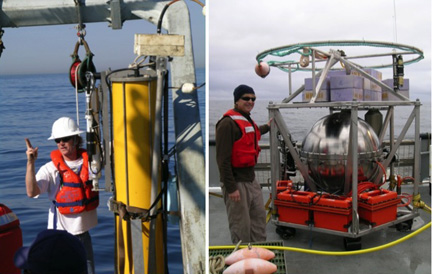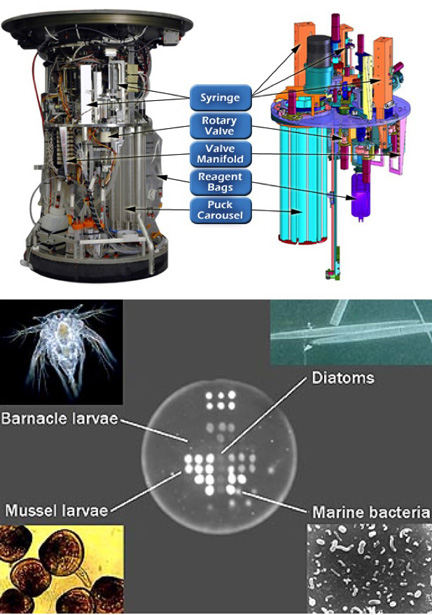 exploring, preserving and protecting the genetic diversity of the world's oceans exploring, preserving and protecting the genetic diversity of the world's oceans
|
OGL Newsletter
|  |
|
|
|
Greetings!
Did you know that robots are no longer science fiction? Instead they are an integral part of today's marine biology research and conservation. From swarming oil skimmers to deep-sea and under-ice explorers, autonomous vehicles let humans enter extreme environments, work for extended periods and travel great distances under water. Read on to see how one such robot has evolved.
And, as always, follow our expeditions and other news from the marine world on our Facebook and Twitter pages!
|
The ESP: A Robotic Undersea Microbiology Laboratory
|
Back in the early 1990's, while still a student in the MIT/WHOI (Woods Hole Oceanographic Institution) Joint Program in Biological Oceanography, Chris Scholin dreamed of creating an autonomous floating laboratory. The device he imagined could spend months or years floating in the open sea, identifying and analyzing microscopic organisms and beaming back data. As a scientist (and now President and CEO) at the Monterey Bay Aquarium Research Institute (MBARI), Scholin is realizing his dream. As he puts it, "They [MBARI scientists and engineers] were about the only people who thought I wasn't crazy." In 2001, Scholin proved them right by building the first generation Environmental Sample Processor (ESP) and deploying it in the Gulf of Maine.
The prototype robot was so promising that MBARI was awarded a number of grants to make a new improved version, which was launched in 2006. G2-ESP was more versatile, more compact, easier to service, more durable and used less power. Not willing to stop there, Scholin continued development with D-ESP, a deep water version capable of sampling at depths of up to 1000m. With the D-ESP scientists can vicariously visit alien worlds like deep-sea cold-water seeps and whale falls in the Monterey Submarine Canyon. In 2010 a commercial version of the ESP was released at the modest price of ~$100,000. Today, these robots can be found monitoring dynoflagellates (the tiny creatures that cause red tide) in Puget Sound and Massachusetts Bay. NASA may even use the technology developed for the ESP in its space exploration programs!
 | |
Chris Scholin poses with (left) the G1 ESP in 2001, and (right) the D-ESP in 2009.
Photos: MBARI
|
How the ESP Works
The ESP has two stages. The first filters seawater to separate particles according to size. The big ones include larvae and single celled animals, and smaller ones include tiny bacteria. Once separated, the filtrates are mixed with special reagents that break open the cells to extract the DNA from their nuclei. The second stage then passes the filtrate over the "puck", a special disk printed with DNA and chemical probe dots. Each dot is designed to detect a different type of organism, and when it does, to glow with a faint erie light. The ESP then takes a photo of the puck and transmits it back to land using a radio transmitter. The puck is stored on board for further analysis when the ESP returns to dry land.
 |
Top: The internal parts of the ESP.
Bottom: Puck Image: The gray circle in the center of this image is a close-up view of a membrane in one of the ESP's "pucks" that has been exposed to a sample of seawater and processed by the ESP's robot laboratory. The locations of the glowing dots within the circle indicate the types of microorganisms that have been detected. A few of these organisms are shown in the photographs surrounding the central image.
Images: MBARI
|
****
See a video of the ESP in action!
|
OGL Open House a True Treasure Trove
| | OGL joined forces with its non-profit neighbors, ArtCorps and the New England Biolabs Foundation, to hold their annual Open House on June 21. Visitors enjoyed presentations on topics from Nicaraguan Marine Biodiversity to A New Strategy for Digestion, all while they sampled the tastes of the Caribbean at the wine bar. Particularly riveting was a video of OGL Director Dan Distel dissecting a 3 foot long giant clam in the Philippines, a show not to be missed!
 | |
OGL Research Assistant Elisha Allan explains the process of genomic archival at the June 2012 OGL Open House.
Photo: OGL
|
|
| Coming Soon... | |
The Exploding Field of Bioinformatics
High intensity math isn't just for engineers and physics nerds anymore. With the upsurge of new analytical technologies and the accompanying mind-blowing tidal wave of data, biologists are finding the need for more powerful computational algorithms going well beyond basic statistics, along with the people to derive them. Join us as we explore this fascinating specialization and bring it home to what we do at OGL.
 | |
The development of the field of Bioinformatics and strong analytical program development is largely responsible for the decoding of the Human Genome.
Illustration: Bishop Heber College
|
|
|
DONATE TO OGL
|
| |
Want to help OGL document and preserve the spectacular genetic diversity of our world's oceans? Visit http://www.oglf.org/Support.htm
|
|
|